Karen Bass, theLos Angelesmayor, lifted a curfew in downtown Los Angeles on Tuesday that was first imposed in response to clashes with police and vandalism amid protests against Donald Trump’s immigration crackdown in the city.
The curfew imposed 10 June provided “successful crime prevention and suppression efforts” and protected stores, restaurants, businesses and residents from people engaging in vandalism, Bass, a Democrat, said.
On Monday, she trimmed back the hours after fewer arrests during evening demonstrations, noting a reduction in violence and vandalism in downtown that followed the protests.
When the curfew was imposed, Bass said the city “reached a tipping point” after 23 businesses were broken into and robbed, which was blamed on agitators looking to cause trouble.
The curfew covered a relatively tiny slice of the sprawling city – a 1-sq-mile (2.5 sq km) section of downtown that includes the area where protests happened.
Last week, Trump ordered the deployment of roughly 4,000 national guard troops and 700 marines to the second-largest US city following protests over his stepped-up enforcement of immigration laws.
On Sunday, Trump directed federal immigration officials to prioritize deportations from Democratic-run cities, a move that comes after large protests erupted in Los Angeles and other major cities against his administration’s immigration policies.
